| Order-3-4 heptagonal honeycomb | |
|---|---|
| Type | Regular honeycomb |
| Schläfli symbol | {7,3,4} |
| Coxeter diagram | |
| Cells | {7,3} 
|
| Faces | heptagon {7} |
| Vertex figure | octahedron {3,4} |
| Dual | {4,3,7} |
| Coxeter group | [7,3,4] |
| Properties | Regular |
In the geometry of hyperbolic 3-space, the order-3-4 heptagonal honeycomb or 7,3,4 honeycomb a regular space-filling tessellation (or honeycomb). Each infinite cell consists of a heptagonal tiling whose vertices lie on a 2-hypercycle, each of which has a limiting circle on the ideal sphere.
Geometry
The Schläfli symbol of the order-3-4 heptagonal honeycomb is {7,3,4}, with four heptagonal tilings meeting at each edge. The vertex figure of this honeycomb is an octahedron, {3,4}.
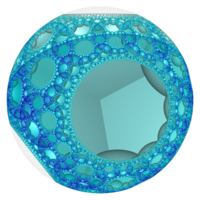 Poincaré disk model (vertex centered) |
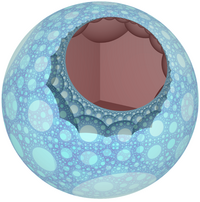 One hyperideal cell limits to a circle on the ideal surface |
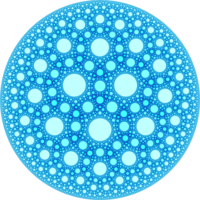 Ideal surface |
Related polytopes and honeycombs
It is a part of a series of regular polytopes and honeycombs with {p,3,4} Schläfli symbol, and octahedral vertex figures:
| {p,3,4} regular honeycombs | |||||||||||
|---|---|---|---|---|---|---|---|---|---|---|---|
| Space | S3 | E3 | H3 | ||||||||
| Form | Finite | Affine | Compact | Paracompact | Noncompact | ||||||
| Name | {3,3,4} |
{4,3,4} |
{5,3,4} |
{6,3,4} |
{7,3,4} |
{8,3,4} |
... {∞,3,4} | ||||
| Image | 
|

|

|

|

|

|

| ||||
| Cells | {3,3} |
{4,3} |
{5,3} |
{6,3} |
{7,3} |
{8,3} |
{∞,3} | ||||
Order-3-4 octagonal honeycomb
| Order-3-4 octagonal honeycomb | |
|---|---|
| Type | Regular honeycomb |
| Schläfli symbol | {8,3,4} |
| Coxeter diagram | |
| Cells | {8,3} 
|
| Faces | octagon {8} |
| Vertex figure | octahedron {3,4} |
| Dual | {4,3,8} |
| Coxeter group | [8,3,4] [8,31,1] |
| Properties | Regular |
In the geometry of hyperbolic 3-space, the order-3-4 octagonal honeycomb or 8,3,4 honeycomb a regular space-filling tessellation (or honeycomb). Each infinite cell consists of an octagonal tiling whose vertices lie on a 2-hypercycle, each of which has a limiting circle on the ideal sphere.
The Schläfli symbol of the order-3-4 octagonal honeycomb is {8,3,4}, with four octagonal tilings meeting at each edge. The vertex figure of this honeycomb is an octahedron, {3,4}.
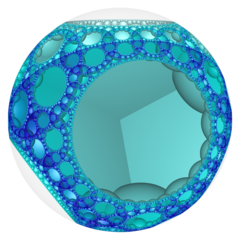 Poincaré disk model (vertex centered) |
Order-3-4 apeirogonal honeycomb
| Order-3-4 apeirogonal honeycomb | |
|---|---|
| Type | Regular honeycomb |
| Schläfli symbol | {∞,3,4} |
| Coxeter diagram | |
| Cells | {∞,3} 
|
| Faces | apeirogon {∞} |
| Vertex figure | octahedron {3,4} |
| Dual | {4,3,∞} |
| Coxeter group | [∞,3,4] [∞,31,1] |
| Properties | Regular |
In the geometry of hyperbolic 3-space, the order-3-4 apeirogonal honeycomb or ∞,3,4 honeycomb a regular space-filling tessellation (or honeycomb). Each infinite cell consists of an order-3 apeirogonal tiling whose vertices lie on a 2-hypercycle, each of which has a limiting circle on the ideal sphere.
The Schläfli symbol of the order-3-4 apeirogonal honeycomb is {∞,3,4}, with four order-3 apeirogonal tilings meeting at each edge. The vertex figure of this honeycomb is an octahedron, {3,4}.
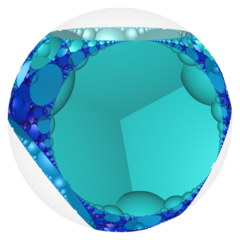 Poincaré disk model (vertex centered) |
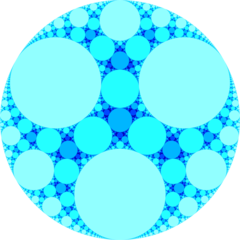 Ideal surface |
See also
References
- Coxeter, Regular Polytopes, 3rd. ed., Dover Publications, 1973. ISBN 0-486-61480-8. (Tables I and II: Regular polytopes and honeycombs, pp. 294–296)
- The Beauty of Geometry: Twelve Essays (1999), Dover Publications, LCCN 99-35678, ISBN 0-486-40919-8 (Chapter 10, Regular Honeycombs in Hyperbolic Space) Table III
- Jeffrey R. Weeks The Shape of Space, 2nd edition ISBN 0-8247-0709-5 (Chapters 16–17: Geometries on Three-manifolds I, II)
- George Maxwell, Sphere Packings and Hyperbolic Reflection Groups, JOURNAL OF ALGEBRA 79,78-97 (1982) [1]
- Hao Chen, Jean-Philippe Labbé, Lorentzian Coxeter groups and Boyd-Maxwell ball packings, (2013)[2]
- Visualizing Hyperbolic Honeycombs arXiv:1511.02851 Roice Nelson, Henry Segerman (2015)
External links
- John Baez, Visual insights: {7,3,3} Honeycomb (2014/08/01) {7,3,3} Honeycomb Meets Plane at Infinity (2014/08/14)
- Danny Calegari, Kleinian, a tool for visualizing Kleinian groups, Geometry and the Imagination 4 March 2014. [3]
